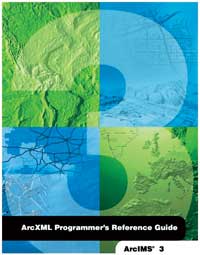|
Editor's note: This article assumes that
the reader is familiar with creating a simple ArcIMS Web site using
the ArcIMS Manager applications--Author, Administrator, and Designer--and
now wants to access additional functionality or modify map display
using Arc Extensible Markup Language (ArcXML), the file format ArcIMS
uses for communication between its components. In addition to describing
in detail how to extend ArcIMS by adding ArcXML elements to the
map configuration file, this article includes an overview of the
structure and syntax of ArcXML.
Three step-by-step companion tutorials are available.
Below are the documents and data you will need to complete these
exercises.
Readers unfamiliar with ArcIMS may want to read
an article that ran in the October-December 2000 issue of ArcUser
magazine, "Creating
GIS-Enabled Web Sites Using ArcIMS," that describes the
process of making a simple ArcIMS Web site.
When using the ArcIMS applications to create a
basic ArcIMS Web site, Author compiles data (e.g., shapefiles, coverages,
ArcSDE layers, and image files) chosen by the user into map layers;
sets functionality such as scale dependency, feature rendering characteristics,
and geocoding; and outputs a map configuration file written in ArcXML.
This map configuration file is used by Administrator to start a
MapService. The ArcIMS Spatial Server parses requests, assembles
and builds requested data, and sends data to clients based on the
specifications set out in the map configuration file.
 |
| This reference lists all ArcXML elements
with a description of the attributes associated with each. |
ArcXML, a derivative of XML, a relative of HTML,
and a subset of SGML, is a meta-markup language that describes structured
data content rather than display information. ArcXML files are text
files with an .axl extension that can be edited. ArcXML defines
content for MapServices as well as for requests from clients, responses
by ArcIMS, and communications between the business logic tier and
servers. By manually inserting ArcXML elements and appending element
attributes in the map configuration file, additional rendering and
labeling options, data subsets, tabular joins, and other capabilities,
not available through the ArcIMS Author interface, can be accessed.
ArcXML Structure and Syntax
All ArcXML statements are constructed using elements
and attributes organized in a hierarchical structure. As part of
this structure, elements are categorized as parent and/or child
elements. Child elements are embedded inside parent elements. Most
elements have one or more attributes. Attributes are a series of
name-value pairs that describe an element. Some ArcXML elements
require attributes. If an attribute is not specified for an element
in the map configuration file, a default value will be used if one
is available for the attribute.
When writing elements and attributes, a strict
convention must be followed or ArcIMS may not be able to create
the MapService. Elements, which identify the nature of the content
being described, must be written in uppercase characters and properly
opened and closed with less than (<) and greater than (>)
characters in a manner similar to HTML code. Attribute names must
be in lowercase characters and the associated values enclosed in
double quotes. Only one attribute value can be defined at a time.
ArcXML Programmer's Reference Guide
Usage for each element and attribute can be found
in the ArcXML Programmer's Reference Guide. This manual,
in PDF format, comes with ArcIMS and is a very useful resource for
learning the structure and hierarchy of ArcXML. It lists all ArcXML
elements with a description of the attributes associated with each.
Required attributes for each element appear in boldface. Attributes
are listed with valid defined values or allowed types of values.
For example, the description for the HASHLINESYMBOL
element includes valid defined values (e.g., foreground and background
for the type attribute) and allowed types of values (e.g., 0,0,0
to 255, 255, 255 for the color attribute). Attribute default values
are enclosed in brackets. Element entries contain hyperlinks to
any parent or child elements. Required child elements are shown
in boldface. Sample code, demonstrating how elements and attributes
are used, is also included. The ArcXML Programmer's Reference Guide
is also available online at the Support Center.
Adding Elements to the Map Configuration File
Edits to the map configuration file can be made
with a simple text editor such as Microsoft WordPad or Microsoft
Notepad or by using an XML editor such as XMLSpy from Altova, Inc.,
or Xeena from IBM alphaWorks. Changes to a map configuration file
affecting map display or other properties will not be seen by clients
until the MapService is refreshed in Administrator. Refreshing causes
the map configuration file to be reread, and the MapService registers
the changes.
The map configuration file must be carefully edited
to ensure that ArcXML syntax is followed exactly. Errors in the
map configuration file will prevent the MapService from refreshing
and cause it to be removed from Administrator. The Message Console,
accessed by choosing Help > Message Console from the menu of
Author or Administrator, displays the error and warning messages
generated by ArcIMS. The following sections describe how modifications
to various elements can affect the map display using symbolization,
labeling, and graphic elements or can be used to query data and
join tables.
Continued on page 2
|

